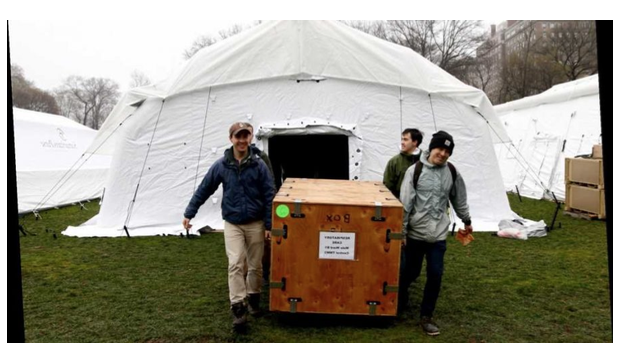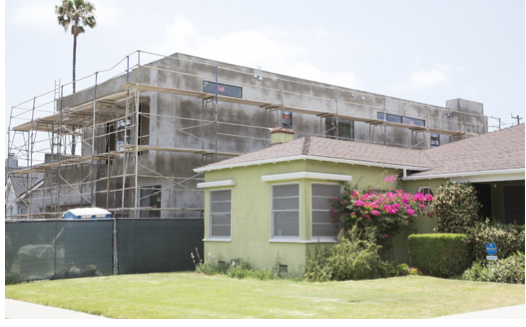CommentsPLANNING WATCH-Last week I wrote about the dubious exemption of construction projects from the State of California’s and City of LA’s shelter-in-place orders.
Since then the Covad-19 Pandemic has gotten much worse, with Drs. Deborah Birk and Anthony S. Fauci forecasting a best-case scenario of 100,000 to 250,000 Coronavirus deaths, while 31 states already have imposed stay-at-home orders. In those locations, like in LA, all retail stores, most personal and commercial services, government offices, gyms, recreation centers and pools, some parks and trails, museums, churches and synagogues, and movie theatres, have closed by choice or to comply with government orders.
But, in LA, nearly all construction projects plod on, oblivious to the worst global public health emergency since the Spanish flu Pandemic of 2018-19, when an estimated 50 million people died. The construction investors and contractors believe, with elected officials in tow, that mandatory closure orders should not apply to their “essential” businesses. These same investors and contractors also assume that their easily replaced and mostly Latino workers are so immune to the Coronavirus that they do not need disinfected construction sites, employer-provided face masks, protective gloves, hand washing stations, and hand sanitizer.
But, do the industry and City Hall justifications for exempting non-essential construction from otherwise broad shelter-in-place executive orders, pass the smell test? Hardly.
Justification #1) “All construction work is essential.” No argument that repairing vital infrastructure, building hospitals, and assembling emergency medical facilities, like the field hospital in New York City’s Central Park, are essential. But beyond that the justifications are not credible.

New York City’s Central Park: Unlike McMansions, the construction of emergency field hospitals is now essential.
There is absolutely nothing essential about such construction projects as commercial office buildings, luxury apartment buildings, and McMansions. Their investors and contractors are in business for one purpose, to make money. Their projects are not fundamentally different from movie theaters, TESLA factories, department stores, boutiques, personal services, and restaurants. Unlike the emergency hospital springing up in NYC’s Central Park, there is no evidence that another McMansion will stem the spread of the Coronavirus. In fact, McMansions replace older, lower-priced homes with expensive houses, without any increase in density or supply. As a result, McMansions inflate the price of existing housing, foster overcrowding, and produce homelessness. At a time when public health professionals tell us that the homeless are the group most vulnerable to Covad19 and may break the back of our hospitals, it is time for City Hall officials to listen to these experts, not real estate industry lobbyists.
Justification #2: Contractors take precautions to protect the health and safety of their construction workers, such as supplying protective gear, installing hand washing and sanitizer stations, and requiring six feet social distancing among employees. Furthermore, according to Curbed LA, Mayor Eric Garcetti said that the City of LA is sending inspectors to construction job sites to enforce these rules.
Sounds great, and since I live in a neighborhood filled with construction projects, I decided to take a look. The Miracle Mile corridor near me has large private buildings being built my major construction companies. It also has an extension of the Purple Line Subway, paid for by METRO, which hired certified contractors employing union labor for it multi-year contracts. There is also a LADWP water main replacement project near me and yet another makeover of LACMA. Last, but not least, the adjacent Beverly Grove and Melrose neighborhoods are chock full of active construction sites for McMansions and new, upscale apartment buildings.
On Monday and Tuesday, I spent many hours observing these construction sites, and it was painfully obvious that contractors are not implementing the high-minded practices that LA’s Mayor crowed about:
- Nearly all construction sites are still open, whether operated by shady mansionizers who pay off workers in cash to avoid withholding and benefits, to large construction companies with union labor and gold-plated contracts from METRO and LACMA.
- A few construction workers wore facemasks, but I suspect they bought brought them from home because none of their colleagues wore them.
- About a third of the construction workers wore gloves, but these were industrial gloves, not surgical gloves supplied by contractors to protect their employees and nearby residents from the Coronavirus Pandemic.
- No work sites had visible dispensers of hand sanitizer or hand washing stations.
- When workers congregated at construction site or left the site, there were not six feet apart. Apparently, the contractors never instructed them on physical distancing practices, even though the same employers boast that construction work is healthy because it keeps employees far apart from each other.
- I saw no evidence of municipal inspectors at these sites enforcing the Mayors Executive Orders or CDC recommendations to slow down the community spread of the Coronavirus.
As the City of LA continues to green light non-essential construction during the Pandemic, other cities and states have taken bolder steps. For example:
- New York City and State - now the Pandemic’s US epicenter -- have changed their construction rules to only allow essential projects.
- Washington State, the country’s previous Coronavirus epicenter, has also banned non-essential construction.
- Alameda and San Francisco Counties’ shelter-in-place orders apply to construction projects.
- As I wrote last week, Boston and Austin do not allow non-essential construction.
Unraveling the exemption. According to Curbed LA and the Wall Street Journal (WSJ), construction industry groups are heavily lobbying politicians to allow their projects to continue. Hidden behind a pay wall, the March 28 WSJ reports, “In Washington, D.C., and in state capitals, industry groups are lobbing to designate construction workers as essential personnel, exempt from stay-at-home orders.” Despite their claims about healthy working conditions, the same WSJ article reports that the Associated General Contracts weekly survey revealed that 13 percent of their respondents knew of a Covad19 infected person at a construction job site.
In the case of Los Angeles, however, we know much more about what goes on behind the closed doors. In a remarkable study, The Garcetti-fication of Los Angeles: A Cautionary Tale, published by Housing is a Human Right in February 2020, City Hall’s real estate game in exposed in precise, fully-documented detail. This is not another titillating story about a corrupt LA City Council member accepting a junket to Las Vegas featuring envelopes stuffed with cash, heavy drinking, and female “escorts.” This is a long, heavily referenced deep dive into LA City Hall’s crooked land use practices, much more than construction projects that get favorable treatment when developers pay-to-play.
According to the February 2020 report, “Lured by favorable local and state governments, zone change approvals, and entire rezoning of neighborhoods, developers and real estate investors jump into inexpensive urban areas before younger people gentrify a community – after all, properties will be less expensive. Developers, with the help of local and state politicians, then fire up gentrification themselves with luxury housing complexes and top-dollar rents. Other landlords in the neighborhood follow suit, jacking up rents – one way or another – of their apartment buildings.”
Then, the same report also drills down deep into City Hall’s shady real estate culture by carefully combing through official data bases: “During Garcetti’s first mayoral term, glass-and-steel luxury-housing towers and gigantic, market-rate apartment complexes started to pop up all over L.A. — and developers and real estate investors, who had contributed millions in campaign cash to Garcetti and City Council members over the years, were raking in billions. By 2018, L.A.-area renters shelled out a staggering $40.4 billion to keep roofs over their heads. Curbed L.A., a real estate site, noted, “By comparison, that’s more than 423 of the companies on the most recent Fortune 500 list earned in yearly revenue’.”
It is hard to appreciate such a remarkable report by quoting a few paragraphs, so I invite CityWatchLA readers to check out the full report at this link.
Los Angeles now faces a critical question: How long will City Hall officials succumb to the influence of real estate interests, what scholars call the urban growth machine and exempt speculative real estate projects, even when they jeopardize the health of the city’s residents? Will it follow the lead of New York and include non-essential construction in its closure orders, or will it insist, despite any evidence, that all construction, such as McMansions, is essential?
(Dick Platkin is a former Los Angeles city planner who reports on local planning issues for CityWatch. He serves on the board of United Neighborhoods for Los Angeles (UN4LA) and is co-chair of the new Greater Fairfax Residents Association. Please send comments and corrections to [email protected].
















